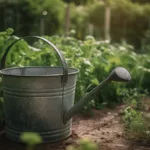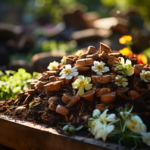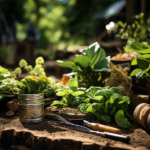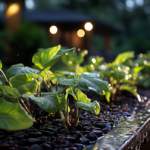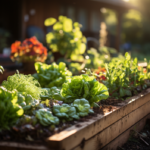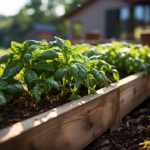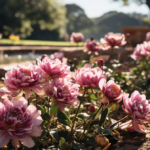Table of Contents
Blooming Beauties: A Complete Guide to Biennial Flowers for a Stunning Garden
Are you ready to add a burst of color and vibrancy to your garden? Look no further than biennial flowers! These stunning plants have a unique growth cycle that spans two years, offering a delightful surprise for every gardening enthusiast.
In this comprehensive guide, we will take you on a journey through the world of biennials. We’ll explore a myriad of beautiful flowers, sharing essential tips and tricks along the way. Whether you’re a seasoned gardener or just starting your green thumb journey, this guide is packed with everything you need to know.
From classic favorites like Foxgloves and Sweet Williams to lesser-known gems like Canterbury Bells and Honesty, we’ll introduce you to a variety of biennial blooms. Discover their fascinating life cycle, from seed to flower, and learn the best practices for sowing, nurturing, and caring for these magnificent plants.
With our expert advice, you’ll learn how to choose the perfect location, prepare the soil, and ensure your biennial flowers thrive in every season. We’ll also share helpful tips on pruning, deadheading, and even collecting seeds for future plantings.
Get ready to unleash your creativity with biennial flowers. Whether you’re designing a cottage garden, creating a colorful border, or simply want to infuse beauty into your outdoor space, this guide will equip you with the knowledge and inspiration to make your garden truly blossom.
So grab your gardening gloves and prepare to embark on an exciting journey through the world of biennial flowers. Let’s transform your garden into a vibrant paradise that will leave your neighbors green with envy!
Choosing the Right Biennial Flowers
When it comes to selecting biennial flowers for your garden, there are a few essential aspects to consider.
Understanding the Biennial Life Cycle: Biennials have a unique growth pattern that spans two years. It’s important to understand how they develop and flower so you can plan for their lifecycle accordingly.
Popular Biennial Flower Varieties: Explore a wide range of biennial flowers, from classic favorites like Foxgloves and Sweet Williams to lesser-known gems like Canterbury Bells and Honesty. Each variety offers its distinct charm and vibrant colors.
Factors to Consider when Selecting Biennial Flowers: Take into account your garden’s growing conditions, such as sunlight exposure, soil pH, and water requirements. Additionally, consider your personal preferences and the aesthetic you want to achieve in your garden.
Preparing Your Garden for Biennial Flowers
Properly preparing your garden sets the stage for healthy growth and abundant blooms.
Soil Preparation for Biennial Planting: Biennials thrive in well-draining soil with rich organic matter. Before planting, amend the soil with compost or well-rotted manure to enhance fertility and drainage.
Sunlight and Water Requirements: Most biennials prefer full to partial sunlight, so ensure they receive adequate light for optimal growth. Watering requirements may vary depending on the specific flower, but regular watering is crucial to keep them hydrated and flourishing.
Proper Plant Spacing for Biennials: Be mindful of each biennial’s recommended spacing to allow sufficient air circulation and prevent overcrowding. This information can typically be found on seed packets or plant tags.
Remember, preparing your garden is a vital step that sets the foundation for successful biennial flower cultivation. Take the time to evaluate your garden’s conditions and make the necessary adjustments to create an ideal environment for your biennial beauties.
Understanding the Biennial Life Cycle: From Seeds to Blooms
Biennial flowers have a unique growth cycle that spans two years, and understanding this process is essential for successful gardening. Let’s dive into the different stages of the biennial life cycle:
- First Year: Seedling Stage: In the first year, biennial flowers start as tiny seeds that germinate and develop into seedlings. During this phase, the focus is on building a strong root system and lush foliage. It’s crucial to provide them with proper care, including regular watering, adequate sunlight, and protection from extreme weather conditions.
- Overwintering: As winter approaches, biennial plants enter a dormant state to survive the cold. Some biennials may remain as compact rosettes, while others completely die back to the ground, depending on the species. Protect them from frost by covering them with a layer of mulch or using protective coverings such as burlap.
- Second Year: Blooming Stage: When spring arrives, the magic happens as biennials transition into their second year. The stored energy from the previous year fuels vigorous growth and the production of stunning blooms. You’ll witness an explosion of colors and fragrances that will transform your garden into a work of art.
It’s important to note that after flowering, biennial plants will set seed, completing their life cycle. The produced seeds can be collected for future plantings or to share with fellow gardening enthusiasts.
By understanding the biennial life cycle, you can plan your garden layout and anticipate when and where these magnificent blooms will appear. Whether you’re growing biennials from seeds or purchasing young plants, knowing what to expect at each stage will enhance your gardening experience and allow you to fully appreciate the beauty of these exquisite flowers.
Sowing and Nurturing Biennials: Essential Tips for Successful Planting
Sowing and nurturing biennial flowers is an exciting and rewarding process that allows you to witness the growth and beauty of these plants from start to finish. Here are some essential tips to ensure successful planting and healthy growth:
- Starting from Seeds: Tips and Guidelines: Begin by selecting high-quality seeds from a reliable source. Follow the instructions on the seed packet for proper sowing depth and spacing. Some biennials require a period of cold stratification before germination, which can be achieved by refrigerating the seeds in damp paper towels for a few weeks.
- Caring for Biennial Seedlings: Once the seedlings emerge, provide them with adequate sunlight or grow lights to promote strong growth. Regularly check the moisture levels in the soil and water gently as needed, ensuring not to overwater or let the soil dry out completely. Thin out the seedlings if they appear crowded, giving each plant enough space to develop.
- Transplanting Biennials into Your Garden: When the seedlings have grown large enough and the frost danger has passed, it’s time to transplant them into your garden. Choose a location that offers the right amount of sunlight and well-drained soil. Dig holes slightly larger than the root balls, place the seedlings in, and gently firm the soil around them. Water thoroughly to help them establish their roots.
Remember to label your biennial plants to keep track of their growth and ensure you know their specific requirements. Regularly monitor them for signs of pests or diseases, and take appropriate action if needed.
By sowing biennial seeds and nurturing the seedlings with care, you’ll have the pleasure of watching these plants transform into magnificent blooms. It’s a truly rewarding experience that allows you to witness the full life cycle of these captivating biennial flowers in your very own garden.
Choosing the Perfect Location: Sunlight, Soil, and Other Considerations
Finding the ideal location for your biennial flowers is crucial to ensure their healthy growth and abundant blooms. Consider the following aspects when selecting the perfect spot in your garden:
- Sunlight Requirements: Most biennial flowers thrive in full to partial sunlight. Ensure your chosen location receives the appropriate amount of sunlight throughout the day. Keep in mind that some biennials, like Foxgloves, tolerate more shade, so adjust accordingly based on the specific needs of the flowers you’ve chosen.
- Soil Conditions: Biennials prefer well-draining soil that is rich in organic matter. Prior to planting, amend the soil by adding compost or organic matter to improve its structure and fertility. Avoid areas with compacted or waterlogged soil, as these can lead to poor plant growth and root rot.
- Space Considerations: Take into account the space requirements of the biennial flowers you intend to grow. Some varieties, like Hollyhocks, can reach impressive heights and may require staking or a taller backdrop. Maintain proper spacing between plants to ensure adequate air circulation and reduce the risk of diseases.
- Companion Planting: Consider the overall garden design and plan for companion plants that will complement your biennials. Some popular choices include partnering biennials with other annuals or perennials, creating beautiful color combinations and providing continuous blooms throughout the season.
- Accessibility and Visibility: If you want to enjoy your biennial flowers up close or showcase them to guests, choose a location that offers easy access and good visibility. Plant them near walkways, patio areas, or along the edges of garden beds to create stunning focal points.
By carefully selecting the perfect location for your biennial flowers, you provide them with the optimal environment to thrive. Remember to consider their sunlight and soil requirements, plan for suitable spacing and companion plants, and position them for maximum accessibility and visual impact. With these considerations in mind, your biennial blooms are sure to make a stunning statement in your garden.
Preparing the Soil: Creating a Nutrient-Rich Environment for Biennial Flowers
Creating a nutrient-rich soil is essential for the optimal growth and blooming of your biennial flowers. Follow these essential tips to prepare the soil for your biennial garden:
- Clearing the Area: Start by removing any existing weeds, rocks, or debris from the planting area. This ensures a clean and open space for your biennial flowers to grow.
- Loosening the Soil: Use a garden fork or tiller to loosen the soil to a depth of about 8-10 inches. This improves drainage, aeration, and root penetration. Break up any large clumps of soil to create a fine texture.
- Amending with Organic Matter: Biennial flowers thrive in soil enriched with organic matter. Add well-rotted compost, aged manure, or leaf mold to improve the soil’s fertility and structure. Work the organic matter into the top few inches of soil.
- Adjusting pH Levels: Check the pH of your soil and ensure it falls within the desired range for your biennial flowers. Most biennials prefer slightly acidic to neutral soil (pH 6.0-7.0). If needed, you can adjust the pH by adding amendments such as powdered lime to raise it or peat moss to lower it.
- Adding Nutrients: Incorporate a balanced granular fertilizer into the soil to provide essential nutrients for your biennials. Choose a product specifically formulated for flowering plants and follow the recommended application rates.
- Watering and Settling: Water the soil thoroughly after amending it to help settle the amendments and ensure even distribution. This also helps prevent air pockets and provides a moist environment to encourage healthy root development.
By preparing nutrient-rich soil, you provide a solid foundation for your biennial flowers to flourish. The organic matter, adjusted pH levels, and added nutrients will support their growth and blooming, resulting in vibrant and healthy plants.
Caring for Biennials: Watering, Pruning, and Deadheading Techniques
Once your biennial flowers are planted and growing, proper care is essential to ensure their health and beauty. Here are some essential techniques for caring for your biennials:
Watering: Consistent and adequate watering is vital for biennials to thrive. While the frequency may vary depending on the specific flower and weather conditions, aim to keep the soil evenly moist. Avoid overwatering, as it can lead to root rot, and underwatering, which can cause wilting and stunted growth. Water at the base of the plants to avoid wetting the foliage, which can invite diseases.
Pruning: Pruning biennials helps maintain their shape, control their size, and encourage bushier growth. After blooming, remove spent flowers and any dead or damaged foliage to keep the plants tidy and stimulate further blooming. Use clean and sharp pruners to make clean cuts, and be mindful not to remove too much healthy foliage as it plays a role in photosynthesis.
Deadheading: Deadheading, the removal of spent flowers, is a beneficial practice that promotes continuous blooming and prevents energy loss through seed production. By removing faded flowers, you redirect the plant’s resources toward new growth and the production of more blooms. Deadhead regularly throughout the growing season, cutting just above a set of healthy leaves or buds.
Regularly monitor your biennial flowers for any signs of pests, diseases, or nutrient deficiencies. Take appropriate action, such as applying organic insecticides or fungicides or providing supplemental fertilization if necessary, to keep your biennials healthy and free from common problems.
Caring for your biennials with proper watering, pruning, and deadheading techniques ensures they remain in optimal condition throughout their growth cycle. Remember to observe their specific requirements and adjust your care accordingly. By investing a little time and effort, you’ll be rewarded with stunning and long-lasting displays of biennial beauty in your garden.
Collecting Seeds: How to Harvest and Store Biennial Seeds for Future Plants
One of the joys of growing biennial flowers is the ability to collect and save seeds for future plantings. Harvesting and storing biennial seeds is a rewarding and cost-effective way to expand your garden. Here’s a step-by-step guide to collecting and preserving biennial seeds:
- Seed Maturity: Allow the biennial flowers to fully mature before collecting seeds. Look for signs of seed ripening, such as dried seed pods, browned petals, or when the seed heads begin to crack open. Timing is crucial, as collecting seeds too early may result in undeveloped or non-viable seeds.
- Seed Collection: Choose a dry and sunny day to harvest your biennial seeds. Bring paper bags, envelopes, or small containers to collect the seeds. Cut the seed heads or seed pods from the plants and carefully place them into your collection container. Label each container with the name of the biennial species and the collection date.
- Seed Drying: After collecting the seeds, ensure they are thoroughly dried to prevent moisture-related issues. Spread them out in a single layer on a clean and dry surface, such as a paper towel or a fine mesh screen. Place them in a warm, well-ventilated area out of direct sunlight. Allow the seeds to dry completely for about 1 to 2 weeks.
- Seed Storage: Once dried, transfer the seeds to airtight containers, such as glass jars or resealable plastic bags. Label the containers with the biennial flower’s name, the collection date, and any other relevant information. Store the containers in a cool, dark, and dry place, such as a pantry or a refrigerator. Proper storage conditions can help maintain the seeds’ viability for several years.
By collecting and storing biennial seeds, you can grow a variety of plants in subsequent years, saving money and ensuring a continuous supply of beautiful blooms. Remember to label and organize your seed collection to keep track of different varieties. With a little planning and care, you can enjoy the joy of nurturing new plants from your very own harvest.
Designing with Biennial Flowers: Creating Stunning Cottage Gardens and Borders
Biennial flowers offer incredible versatility and beauty, making them a perfect choice for designing stunning cottage gardens and borders. Here are some essential tips to help you create captivating floral displays with biennials:
Choose a Theme: Decide on the overall theme or style you want to achieve in your garden. Cottage gardens often evoke a charming and romantic ambiance, with a mix of colorful flowers and lush foliage. Consider the color palette, plant heights, and textures that will harmonize with the desired theme.
Layering and Height: Create depth and visual interest by incorporating biennials of different heights. Plant taller varieties, such as Foxgloves or Delphiniums, toward the back to provide a backdrop for shorter plants like Sweet Williams or Pansies in the front. This layering effect adds dimension to your garden.
Color Combinations: Select biennial flowers with complementary or harmonizing colors to create eye-catching displays. Classic cottage garden color schemes often include soft pastels, vibrant pinks, purples, and whites. Experiment with different combinations to achieve the desired visual impact.
Successional Planting: To extend the blooming season, integrate successional planting techniques. Plant biennial flowers with varying bloom times and stagger their plantings so that as one set of blooms fades, another set is ready to take their place. This ensures a continuous display of vibrant colors throughout the growing season.
Mix with Perennials and Annuals: To add even more variety and texture to your garden, incorporate biennials alongside perennial and annual plants. This combination will provide year-round interest and ensure that your garden has a diverse and ever-changing display.
Remember to consider the individual needs of each biennial flower, including sunlight and water requirements, when planning their placement in your garden. Regularly deadhead spent blooms to promote continuous flowering and keep your garden looking tidy.
With careful planning and a thoughtful mix of biennial flowers, you can create a captivating cottage garden or border that will be the envy of all. Enjoy the beauty and charm of these delightful plants as they transform your outdoor space into a whimsical floral haven.
Extending the Bloom Season: Companion Planting with Biennials and Perennials
Companion planting is a fantastic technique for extending the blooming season in your garden. By strategically combining biennial flowers with perennials and other annuals, you can ensure a continuous display of vibrant colors throughout the year. Here’s how to make the most of companion planting:
Choose Complementary Blooming Periods: Select biennial flowers with overlapping or successive blooming periods to ensure a continuous show of color. Pair early-blooming biennials like Sweet Williams or Wallflowers with late-blooming perennials or annuals to bridge the gap between seasons and keep your garden vibrant.
Match Growth Habits: Pair biennial flowers with companion plants that have similar growth habits to create a harmonious and visually appealing arrangement. Look for plants with compatible heights, forms, and structures. For example, tall biennials like Hollyhocks can be complemented by statuesque perennials or tall grasses.
Consider Color Harmonies: Combine biennials with perennials and annuals that have complementary or contrasting colors to create striking visual effects. Harmonize warm-toned biennials like Sunflowers or Marigolds with cool-toned Perennials to add depth and interest to your garden. Don’t be afraid to experiment and create unique color combinations that reflect your personal style.
Fill in Gaps with Annuals: Use annual flowers to fill temporary gaps in your garden beds. Annuals like Pansies, Zinnias, or Petunias can provide continuous blooms while your biennials are in their off-season or as you wait for perennial flowers to mature. This ensures your garden remains vibrant and colorful throughout the year.
By combining biennial flowers with perennials and annuals, you can extend the blooming season and create a dynamic and ever-changing landscape. The beauty and diversity of these combined plantings will keep your garden a source of delight for months on end.
Remember to adjust watering and fertilizing practices to meet the needs of all plants in your companion planting scheme. Regularly deadhead spent blooms and monitor for any signs of pests or diseases to maintain the health and appearance of your garden.
Troubleshooting Common Biennial Flower Issues: Pests, Diseases, and Solutions
While biennial flowers are generally resilient, they can sometimes encounter problems with pests and diseases. Being aware of common issues and knowing how to address them will help keep your biennial garden healthy and thriving. Here are some common problems and their solutions:
Pests:
- Aphids: These small, sap-sucking insects can distort new growth and stunt the overall health of your plants. Spray a strong jet of water or use insecticidal soap to control them. Ladybugs and lacewings are natural predators that can also help keep aphids in check.
- Slugs and Snails: These slimy creatures love to feast on tender foliage and flowers, leaving behind telltale silvery trails. Minimize their presence by creating barriers such as copper tape or beer traps. Handpicking them during evening hours can also be effective.
- Caterpillars: Caterpillars can cause substantial damage by feeding on leaves and flowers. Identify the specific caterpillar and use targeted methods to control them. Handpicking, applying organic pesticides, or introducing beneficial insects like wasps or birds can help manage caterpillar populations.
Diseases:
- Powdery Mildew: This fungal disease appears as a powdery white coating on leaves, inhibiting photosynthesis and weakening the plant. Improve air circulation by spacing plants adequately and avoid overhead watering. Apply fungicidal sprays if necessary.
- Botrytis Blight: Also known as gray mold, this disease can cause rotting and wilting of flowers and foliage. Remove and destroy affected plant parts, provide proper air circulation, and ensure plants are not overcrowded. Avoid overhead watering and apply a fungicide, if needed.
- Root Rot: Overly moist soil can lead to root rot, causing wilting, discolored leaves, and plant decline. Improve soil drainage and avoid overwatering. If root rot is detected, remove affected plants and make sure to sterilize your tools before use.
Regularly inspect your biennial flowers for any signs of pests or diseases, especially on the underside of leaves or stems. Diagnose the problem promptly to implement the most effective solution. Additionally, practising good garden hygiene, such as removing fallen debris and practicing crop rotation, can help prevent future issues.
By addressing common biennial flower problems proactively, you can ensure the health and vitality of your garden, allowing your biennials to shine with their full potential.
No products found.
Conclusion
In conclusion, biennial flowers add an enchanting touch to any garden with their unique growth cycle and stunning blooms. With our comprehensive guide, you now have the knowledge and tools to successfully incorporate biennials into your own garden paradise.
From choosing the perfect varieties and preparing the soil to sowing seeds, nurturing seedlings, and caring for mature plants, each step of the biennial journey has been covered. You’ve discovered the art of collecting and storing seeds, extending the blooming season through succession planting, and dealing with common pests and diseases.
Through companion planting and thoughtful garden design, you can create breathtaking displays and enjoy a year-round burst of color and fragrance. Whether you’re aiming for a charming cottage garden, vibrant borders, or unique combinations with perennials and annuals, biennial flowers offer endless possibilities.
So, put on your gardening gloves, grab your favorite tools, and let your creativity bloom! With the guidance provided in this comprehensive guide, your garden will flourish with the beauty and vibrancy of biennial flowers.
Explore the wide range of biennial varieties available and experiment with different planting techniques to create your own horticultural wonderland. Remember, gardening is a continuous journey of learning and growth, so embrace the process and enjoy the rewards of a bountiful biennial garden.
May your garden be a constant source of joy, inspiration, and respite—a place where biennial flowers bloom and dreams take root. Happy gardening!


